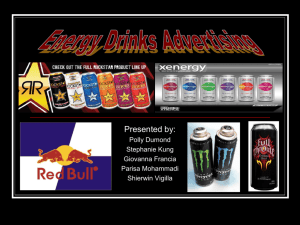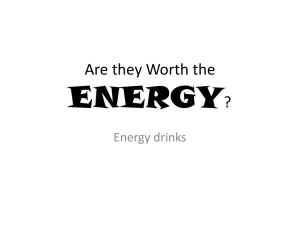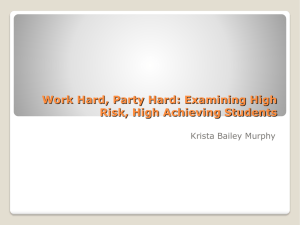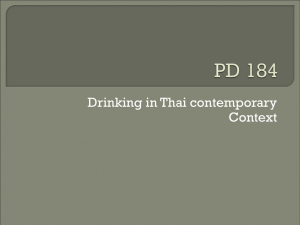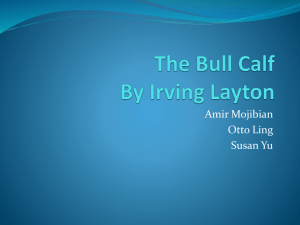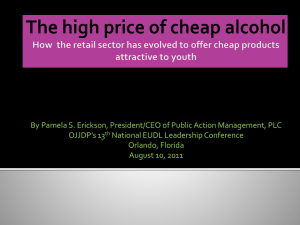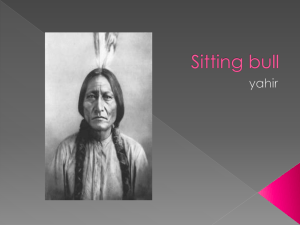Energy Drinks
advertisement
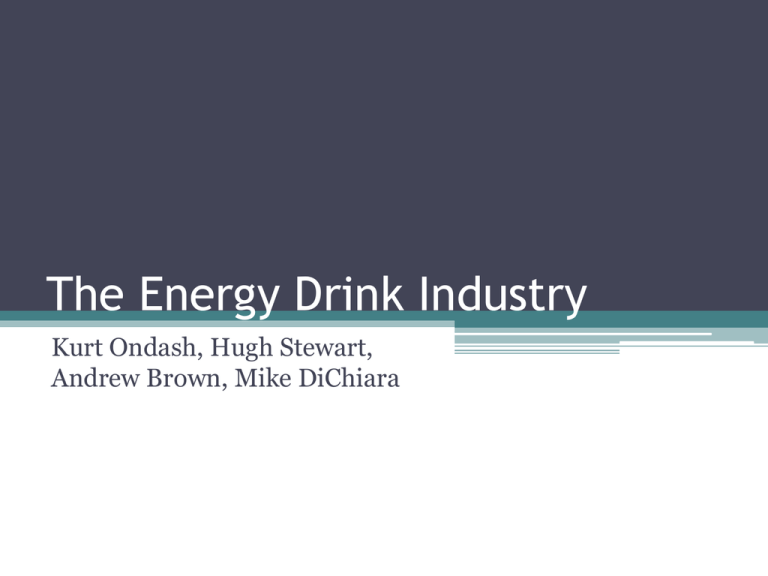
The Energy Drink Industry Kurt Ondash, Hugh Stewart, Andrew Brown, Mike DiChiara Why the Energy Drink Industry? • College students a major target population • Substantial industry growth in past decade • Similar ingredients lead to importance of pricing strategies • Health concerns and side effects Functional Beverage • Energy drinks categorized as a Functional Beverage ▫ A non-alcoholic drink that includes in its formulation ingredients such as herbs, minerals, vitamins, amino acids and/or additional raw fruit or vegetables ▫ Often claim specific health benefits Functional Beverage Industry Nutraceutical Drinks 10% Sports Drinks 27% US Functional Beverage Industry Energy Drinks 63% Energy Drinks • Beverages that contain caffeine in combination with other presumed “energy enhancing” ingredients such as taurine, herbal extracts and B Vitamins • Energy drink segment includes options such as shots, ready-to-drink and powder forms • Focusing on the traditional canned energy drink Industry Analysis Background • Perceived effects: ▫ Increased mental performance ▫ Increased physical performance • Potential ingredients: ▫ ▫ ▫ ▫ ▫ ▫ High level of caffeine Herbs B vitamins Guarana Taurine etc. Financing and Distribution • Financing ▫ Use existing infrastructure AMP using PepsiCo ▫ Create entirely different company Red Bull • Distribution ▫ Usually use large beverage companies Monster uses Coca Cola Typical Customer • Originally: ▫ Target athletes • Currently: ▫ ▫ ▫ ▫ Young adults (teenagers and people in their 20s) Overworked individuals Hip hop crowd Extreme Sports Enthusiasts Firms in the Industry • • • • • Only including energy drink cans NOT energy shots or vitamin water About 200 brands Over 300 varieties of energy drinks Top three energy drinks: ▫ Red Bull ▫ Monster ▫ Rockstar Herfindahl-Hirshman Index (HHI) Barriers to Entry • Barrier to entry is not extremely high ▫ Industry very profitable ▫ Low initial investment if infrastructure in place • Hard to compete with leading energy brands ▫ Top 2 energy drinks control 80 percent of market Product Differentiation • Energy drinks are different based on: ▫ Ingredients ▫ Health (low-calories, low-sugar, lowcarbohydrates) ▫ Countries drinks are sold ▫ Regulations Top Energy Drink Sales 2010-2012 $3,500 Energy Drink Industry Sales $3,000 Sales (millions) $2,500 Red Bull $2,000 Monster Rockstar $1,500 Amp NOS Full Throttle $1,000 $500 $0 2010 2011 Year 2012 Top 3 Energy Drinks #1 #2 #3 Red Bull • Launched in Austria,1987 • Started by group of investors • More than 35 billion cans sold • 5.2 billion cans sold in 2012 • In 165 countries • Grew 15.9% in sales in 2012 • Invests heavily in Formula 1 Championships • Slogan: “Red Bull gives you wings” Monster • Launched by Hansen Beverage Corporation • Over 25 different energy drinks sold • Coca Cola Used as distributor • Advertises by supporting “the scene, the bands, our athletes and our fans” • Over 8 billion cans sold since product launched • Slogan: “Unleash the Beast!” Rockstar • Created in 2001 as independently owned venture • 20 different flavors • In 30 countries • Uses PepsiCo as distributor • Gained market share by selling a drink that is “twice the size of Red Bull, but sold at the same price” • Slogan: “Party like a Rockstar” Pricing Strategies Main Pricing Strategies • Tacit Collusion ▫ Promotional Strategies • Price Leadership • Second Degree Price Discrimination ▫ Drink Sizes ▫ Drink Quantities Tacit Collusion Tacit Collusion • Seemingly independent, but parallel actions among competing firms • Not a formal agreement • Seen in energy drink industry with price matching Tacit Collusion • A lack of significant product differentiation and production costs • Similar ingredients found across all brands: ▫ B-Group Vitamins ▫ Taurine ▫ Ginseng Promotional Strategies • Similar promotional strategies across the industry ▫ Focus on sponsoring extreme sport athletes/events ▫ Promote brand image by targeting events with “high energy” • Emphasize the overall experience, not just the drink Promotional Strategies • Each of the major brands employ on campus student reps • Goal is to create brand awareness ▫ Free giveaways ▫ Providing energy drinks at parties ▫ Promoting on-campus events Tacit Collusion • Industry dominated by 2 major firms: ▫ Red Bull (42% market share) ▫ Monster (37% market share) • Consistent industry growth in sales with a small number of competing firms Tacit Collusion Fastrac Brand Size (oz.) Monster Red Bull AMP NOS Rockstar Full Throttle Quantity 16 16 16 16 16 16 Price 1 1 1 1 1 1 $2.69 $3.99 $2.49 $2.69 $2.49 $2.49 Price/Total oz. $0.17 $0.25 $0.16 $0.17 $0.16 $0.16 Price Leadership Price Leadership • Occurs when a firm leader in its sector determines the price of the product • Competitors may choose to lower prices in hopes of capturing market share • Energy Drink Price Leader: Red Bull Price Leadership • Raw data regarding prices collected from: ▫ Wal-Mart (wholesale retailer) ▫ Fastrac (gas station) ▫ Universal Deli (corner store) • Survey taken by 100 current college students: ▫ Energy drink consumption/preferences Price Leadership Price Leadership • Wal-Mart Energy Drink Prices: Price Leadership • Fastrac Energy Drink Prices: Price Leadership • Universal Deli Drink Prices: Price Leadership • Survey shows 60% of students prefer to consumer energy drinks with alcohol • Red Bull Vodka very popular among college students • Red Bull is only energy drink offered at most bars Second Degree Price Discrimination Second Degree Price Discrimination • Induce customers to select into high and low price groups themselves. • Key constraint: you can’t make the inexpensive version too attractive to those willing to pay more. • Often firms cannot distinguish between groups of consumers based on observable characteristics ▫ Offer a menu of alternatives Second Degree Price Discrimination • Each brand offers a variety of different sizes • The Starbucks example holds true in the energy drink industry • 42% of students prefer a medium sized 12oz. option Second Degree Price Discrimination • Each brand offers a variety of different quantities to purchase • Different product packages offered depending on store type ▫ Individually, 4 pack, 12 pack, 24 pack • 77% of students prefer to purchase individually Second Degree Price Discrimination • Versioning: create different versions of virtually the same product to appeal to different types of buyers • Customers choose the version that best meets their needs Recommendations Industry Regulation • FDA limits caffeine content of cola-type soft drinks to 0.02% caffeine, or 71mg/12 fluid oz • At least 130 energy drinks exceed this level • EU requires energy drinks to have a “high caffeine content” label • Canada requires labels indicating that Red Bull should not be mixed with alcohol Regulation • FDA does not require warning labels advising proper use or amount of caffeine in product • OTC caffeine-containing stimulants must contain specific warnings and directions on product label • Striking inconsistencies between OTC stimulant medications and energy drinks Caffeine Comparison Energy Drink Ounces per can Total Caffeine (mg) Red Bull 8.4 80 Monster 16 160 Rockstar 16 160 NOS 16 250 SPIKE Shooter 8.4 300 Wired X505 24 505 Health Concerns • Adverse side effects and increased health risks have been linked to consumption ▫ Includes elevated blood pressure, cardiac arrhythmia and seizures • Lack of adequate labeling, aggressive advertising, and consumer demographics all make risks of energy drinks greater • Caffeine intoxication, dependence and withdrawal FDA Actions • Announced investigation into energy drink related deaths • Congress sanctioning preliminary exploration into caffeine and stimulant levels, and marketing tactics • In response Red Bull and Monster hired lobbying firms • 2010 – under threat of further FDA restrictions, Four Loko agreed to remove stimulants from product Investment Recommendation • Increased regulatory scrutiny makes industry future very uncertain • Monster Beverage Company (MNST) Recommendations • Development of lower caffeine products • Focus on creating a healthier alternative from both a ingredient and marketing perspective ▫ Potential regulations could shift target market • Regulation could create opportunities for market/price leadership • Consumers have shown willingness to pay premium for healthier option
